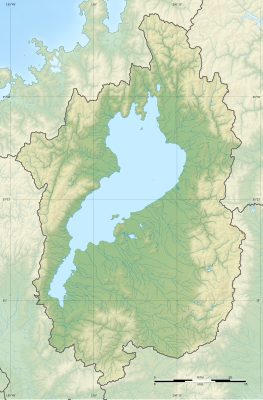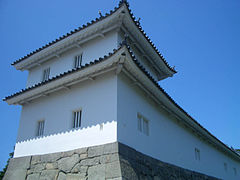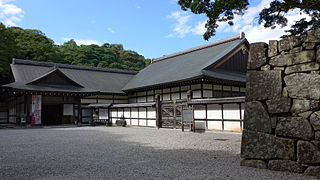Hikone Castle
| Hikone Castle | ||
|---|---|---|
|
The castle tower of Hikone Castle |
||
| Creation time : | 1603 | |
| Castle type : | Hirayamajiro (hill castle) | |
| Conservation status: | Castle tower, walls and moat preserved, residence reconstructed | |
| Construction: | Stone, wood | |
| Place: | Hikone | |
| Geographical location | 35 ° 16 '35 " N , 136 ° 15' 6.3" E | |
|
|
||
The Hikone Castle ( Japanese 彦根城 Hikone-jō ) is a famous Japanese castle in Hikone in Shiga Prefecture in Japan . It has a castle tower, which is one of the most beautiful preserved.
history
This Edo period castle dates back to 1603 when Ii Naokatsu , the son of the former daimyo Ii Naomasa , ordered its construction. The fortification was originally built in 1575 as part of Ōtsu Castle and then moved to Hikone by the Ii. It was completed in 1622. Naokatsu's lands had been taken from him by the Tokugawa shogunate during this time , and when his brother Naotake took control of the area around Ōmi province , he was able to complete the castle using stones from the earlier Sawayama Castle. An important representative of the family was Ii Naosuke , who served the shogunate as Chancellor (Tairō) in the mid-19th century.
Castle complex
The castle is located on an elongated hill that used to extend to a bay on Lake Biwa . The castle is completely surrounded by the inner moat ( 内 濠 Uchibori ), which is surrounded by another, the outer moat ( 外 濠 Sotobori ). At the bottom of the water, the castle is partially protected by walls, but in large areas they were content with an earth wall. At the top, the castle is completely protected by walls.
Three gates are available for access to the castle: the main gate ( 大 手 門 Ōte-mon ; 14 in the drawing), the front gate ( 表 門 Omote-mon ; 7), which leads directly to the residence ( 表 御 殿 Omote-goten ; R ) on the right, and the Black Gate ( 黒 門 Kuro-mon ; 9), which leads to the former secondary residence. At the rear of the residence there was another entrance to the castle, the rear gate ( 裏 門 Ura-mon ; 8).
If you enter the castle through the front gate, you go past the residence up a flight of stairs to the bell bailey ( 鐘 の 丸 Kane-no-maru ; 13) and on to the second bailey, to which you cross the corridor bridge ( 廊下 橋 Rōka-bashi ), with which the deeply cut trench is crossed, which one has passed before. On the castle side it is protected by the wide gate, the Libra Gate ( 天秤 櫓 Tembin-yagura ; 3; ◎ = important cultural asset ). Behind the gate on the left is a wooden frame with a bell that announces the time. Then you come through the drum gate ( 太 鼓 櫓 Taiko-yagura ; 2) to the central castle area, the Hommaru ( 本 丸 Hommaru , A) with the preserved castle tower ( 天 守 閣 Tenshukaku ; 1).
Further north follows the second castle area, the elongated Ni-no-maru ( 二 ノ 丸 ; B). At its northwest corner there is a three-story watchtower ( 三重 櫓 Sanjū-yagura ; 5; ◎). Again over a bridge you come to the upstream castle area, the Kannon-dai ( 観 音 台 ; 6).
At the bottom of the northern tip of the castle is the Yamasaki bailey ( 山崎 曲 輪 Yamasaki-kuruwa ; 10), to which there was an entrance ( 山崎 口 Yamasaki-guchi ; 11). In the west at the foot of the castle hill stood the rice granaries (S) and on the east side there was the Keyaki residence ( 槻 御 殿 Keyaki-goten ; N).
Hikone Castle after 1868
When the Meiji Period began in 1868 , many castles were destroyed. The castle tower was only preserved following the intervention of the emperor himself, who was touring the area. Today it is one of the twelve preserved castle towers and certainly one of the most beautiful in Japan. The area of the Keyaki residence was preserved as a garden. - 1985–1987 the representative front part of the former residence including a Noh stage with an area of 4851 m² was reconstructed for use as a museum. As a national treasure, the museum owns the six-part Hikone screen .
In 1951 the original complex was declared a special historical site and in 1952 the castle tower was declared a national treasure of Japan by the Ministry of Culture .
photos
Remarks
- ↑ The structure has the appearance of a scale with a tower structure on the right and left like two weights.
literature
- Hikone Museum (Ed.): Hikone Castle Museum. no year
- Yasuhiro Nishigaya (Ed.): Hikone-jo. In: Nihon meijo zukan. Rikogaku-sha, Tokyo 1993, ISBN 4-8445-3017-8 .
Web links
- Information about the castle ( Memento from March 5, 2016 in the Internet Archive ) in English
- Photos of Hikone Castle - English








